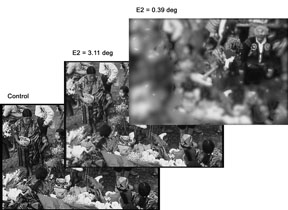Matching the Drop-Off of Image Resolution in Gaze-Contingent Multi- Resolutional Displays to Human Visual Resolution

The main goal for designers of gaze-contingent multi-resolutional displays has been to create display images that remove all of the information that users cannot perceive (because this information is located in their visual periphery), yet the images are not perceptibly different from full high-resolution images. To do this, they must create images in which image resolution decreases with the distance from the center of vision at the same rate that human visual resolution decreases.
Our work on this topic is the most thorough investigation of perception and performance to date (Loschky, McConkie, Yang & Miller, 2005) and provides the first rigorous proof of a gaze-contingent multi-resolutional display that maximizes savings while being imperceptibly different from a constant high-resolution image. It also provides the first estimate of the limits of visual resolution in freely viewed natural scenes, providing a basis for predicting what information affects scene perception in different parts of the visual field. This work is in collaboration with Jian Yang and Michael Miller of Eastman Kodak, and George McConkie at the University of Illinois.